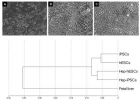Filtering kitchen wastewater for plants
2011-01-06
(Press-News.org) Water is a precious commodity, so finding ways to re-use waste water, especially in arid regions is essential to sustainability. Researchers in India have now carried out a study of various waste water filtration systems for kitchen waste water and found that even the most poorly performing can produce water clean enough for horticultural or agricultural use. They report details in the International Journal of Environmental Technology and Management.
Recycling domestic wastewater is becoming an important part of water management and emerging technology and a shift in attitude to waste in the developing world means that more people would be willing to re-use this so-called gray water given the choice. Unfortunately, affordable and effective domestic wastewater treatment is not yet available particularly in parts of the world where financial and technical constraints are acute. Nevertheless domestic wastewater from showers, kitchen sinks and laundry washing in homes and offices offers a potential resource that differs from industrial wastewater. Domestic waste water might contain an organic load from food processing, utensil washing in the kitchen, soap and detergents, with the main contaminants being proteins, carbohydrates, detergents, oil and grease and other dissolved and suspended compounds.
Subrata Dasgupta of the Council of Scientific and Industrial Research, in Kolkata, and colleagues have explored the potential of ceramic microfiltration membrane s used alone or in conjunction with different physicochemical treatments, such as biotreatment and adsorption, for cleaning up dirty dishwater. The team compared cross-flow microfiltration (CMF) with tubular ceramic membranes in single channel and multichannel configurations. Biotreatment involved using activated sludge or an adsorptive treatment based on the prepared dried roots of Eichhornia crassipes, an aquatic weed that grows well in polluted water.
The researchers found that, as one might expect, a 19-channel ceramic membrane performed better in terms of permeate quality than a single-channel filter. In terms of BOD (biological oxygen demand), COD (chemical oxygen demand), turbidity, TSS (total suspended solids), microfiltration of the waste water treated with adsorbent appeared to be most promising compared with other the approaches tested. In that approach, 98% removal of BOD and 99% removal of COD were seen. The quality of the treated water was found to be fit for use in horticulture and irrigation, the team concludes.
INFORMATION:
"Comparative study on treatment of kitchen-sink wastewater using single and multichannel ceramic membrane" in Int. J. Environmental Technology and Management, 2010, 13, 336-347
END
ELSE PRESS RELEASES FROM THIS DATE:
2011-01-06
Two ESA observatories have combined forces to show the Andromeda Galaxy in a new light. Herschel sees rings of star formation in this, the most detailed image of the Andromeda Galaxy ever taken at infrared wavelengths, and XMM-Newton shows dying stars shining X-rays into space.
During Christmas 2010, ESA's Herschel and XMM-Newton space observatories targeted the nearest large spiral galaxy M31. This is a galaxy similar to our own Milky Way – both contain several hundred billion stars. This is the most detailed far-infrared image of the Andromeda Galaxy ever taken and ...
2011-01-06
A study by Canadian researchers examined the prevalence of maternal depression and its impact on children newly diagnosed with epilepsy. Prevalence of depression in mothers ranged from 30%-38% within the first 24 months following a child's epilepsy diagnosis. The mother's depressive symptoms negatively impacted the child's health-related quality of life, but the effects were moderated by the amount of family resources and mediated by how well the family functions and the extent of family demands. Details of this novel study appear online in Epilepsia, a journal published ...
2011-01-06
How to look younger without plastic surgery? Psychologists of the Jena University (Germany) have a simple solution to this question: Those who want to look younger should surround themselves with older people. Because when viewing a 30-year-old we estimate his age to be much younger if we have previously been perceiving faces of older people.
"People are actually quite good at guessing the age of the person next to them," Dr. Holger Wiese says. The psychologist of the Jena University is responsible for one of six research projects in the DFG-sponsored research unit "Person ...
2011-01-06
Scientists at Inserm and Institut Pasteur have performed biomarker discovery on patients being treated for chronic hepatitis C infection. Their work, published in The Journal of Clinical Investigation, demonstrates that the plasma levels of the protein IP-10 predict, prior to treatment initiation, the efficacy of treatment with pegylated-interferon and ribavirin. Based on these results, the scientists have developed a prognostic test. Commercialization is anticipated in 2011, and will help inform physicians of the chances that patients will respond to standard treatment ...
2011-01-06
Severely injured patients transported by helicopter from the scene of an accident are more likely to survive than patients brought to trauma centers by ground ambulance, according to a new study published in The Journal of Trauma: Injury, Infection, and Critical Care. The study is the first to examine the role of helicopter transport on a national level and includes the largest number of helicopter-transport patients in a single analysis.
The finding that helicopter transport positively impacts patient survival comes amid an ongoing debate surrounding the role of helicopter ...
2011-01-06
As every middle-school child knows, in the process of photosynthesis, plants take the sun's energy and convert it to electrical energy. Now a Tel Aviv University team has demonstrated how a member of the animal kingdom, the Oriental hornet, takes the sun's energy and converts it into electric power -- in the brown and yellow parts of its body -- as well.
"The interesting thing here is that a living biological creature does a thing like that," says physicist Prof. David Bergman of Tel Aviv University's School of Physics and Astronomy, who was part of the team that made ...
2011-01-06
Boston, MA – A new study of men with prostate cancer finds that physical activity is associated with a lower risk of overall mortality and of death due to prostate cancer. The Harvard School of Public Health and University of California, San Francisco researchers also found that men who did more vigorous activity had the lowest risk of dying from the disease. It is the first study in men with prostate cancer to evaluate physical activity after diagnosis in relation to prostate cancer-specific mortality and overall mortality.
The study appears in an advance online edition ...
2011-01-06
PROVIDENCE, RI – When methicillin-resistant S. aureus (MRSA) is carried in the nose (nares), it is a risk factor for an invasive infection, including a surgical site infection. Some studies have found that the heavier the carriage of MRSA in the nose, the greater the risk of transmission to others and the greater risk of infection to the patient. Few studies to date have assessed the differences in quantity of MRSA at different body sites. A new study from Rhode Island Hospital now sheds light on both the quantity of MRSA at different body sites and the relationship between ...
2011-01-06
Using a thermostatic mixer valve to control the maximum temperature of children's bath water can significantly reduce the temperature of hot bath water and should reduce the risk of scalding, according to researchers at The University of Nottingham.
The study, carried out in partnership with Glasgow Housing Association, found that families with a thermostatic mixing valve (TMV) fitted to the hot and cold water pipes in their bathroom had bath water temperatures that were up to 11˚C cooler than those without and their baths were within the recommended temperature ...
2011-01-06
Numerous patients suffering from chronic liver diseases are currently receiving inadequate treatment due to the lack of organs donated for transplantation. However, hepatocytes derived from induced pluripotent stem cells (iPSCs) could offer an alternative for the future. Scientists from the Max Planck Institute for Molecular Genetics in Berlin compared hepatocytes from embryonic stem cells with hepatocytes from iPS cells and found that their gene expression is very similar. Nevertheless, in comparison to "real" hepatocytes, just under half of the genes exhibited a different ...
LAST 30 PRESS RELEASES:
[Press-News.org] Filtering kitchen wastewater for plants


